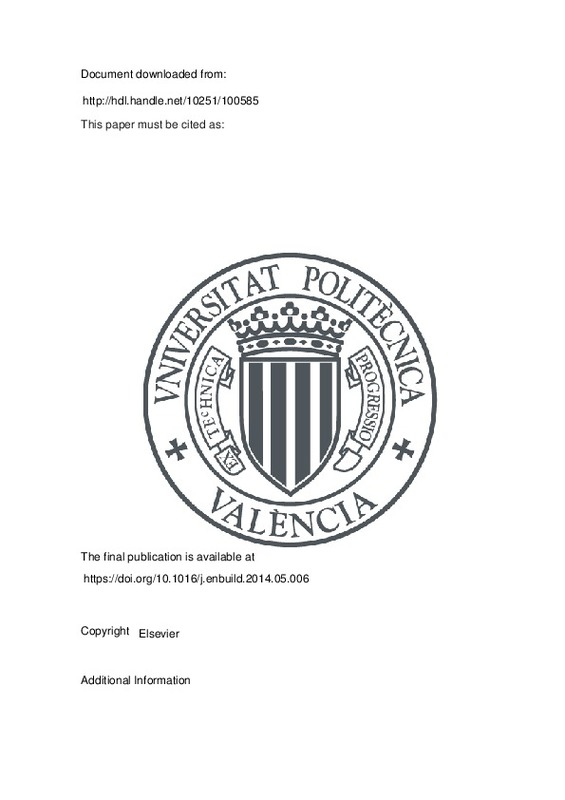JavaScript is disabled for your browser. Some features of this site may not work without it.
Buscar en RiuNet
Listar
Mi cuenta
Estadísticas
Ayuda RiuNet
Admin. UPV
Thermal behavior analysis of different multilayer façade: Numerical model versus experimental prototype
Mostrar el registro sencillo del ítem
Ficheros en el ítem
| dc.contributor.author | Guillén Guillamón, Ignacio Enrique
|
es_ES |
| dc.contributor.author | Gómez Lozano, Vicente
|
es_ES |
| dc.contributor.author | Fran Bretones, José Mª
|
es_ES |
| dc.contributor.author | López Jiménez, Petra Amparo
|
es_ES |
| dc.date.accessioned | 2018-04-19T04:12:09Z | |
| dc.date.available | 2018-04-19T04:12:09Z | |
| dc.date.issued | 2014 | es_ES |
| dc.identifier.issn | 0378-7788 | es_ES |
| dc.identifier.uri | http://hdl.handle.net/10251/100585 | |
| dc.description.abstract | [EN] In this paper, different sorts of façades have been analyzed considering their thermal performance along a 24 h period. A numerical model was developed and compared with experimental measurements considering two different façades for buildings: on one side an opaque multilayer façade; and on the other side, a ventilated façade. The numerical model representing the temperature in every layer of the façades was successfully validated. This model was used for determining the thermal behavior of two new ventilated façades in which the thermal mass had been changed, observing then that the existence of the movements in the air gap affected particularly the air temperature and the thermal transmittance of the façade while the sun hitting the façade, leading to a reduction of transmittance close to 30% along the air chamber. This effect is very important in warm climates and becomes a key-factor for decreasing the cooling needs of buildings in summer with no need of increasing the mass of the façade | es_ES |
| dc.description.sponsorship | The evaluation of the different facade systems, by modifying multilayer sandwich panels was performed in the framework of the E3 EDIFICACION ECO EFICIENTE project. The research project was cofounded by CDTI and a consortium of companies formed by BECSA, CERACASA, Rockwool Peninsular, ATERSA and APLICAD. | en_EN |
| dc.language | Inglés | es_ES |
| dc.publisher | Elsevier | es_ES |
| dc.relation.ispartof | Energy and Buildings | es_ES |
| dc.rights | Reserva de todos los derechos | es_ES |
| dc.subject | Thermal analysis | es_ES |
| dc.subject | Numerical model | es_ES |
| dc.subject | Ventilated facade | es_ES |
| dc.subject | Thermal transmittance | es_ES |
| dc.subject.classification | INGENIERIA HIDRAULICA | es_ES |
| dc.subject.classification | CONSTRUCCIONES ARQUITECTONICAS | es_ES |
| dc.subject.classification | FISICA APLICADA | es_ES |
| dc.subject.classification | MECANICA DE FLUIDOS | es_ES |
| dc.title | Thermal behavior analysis of different multilayer façade: Numerical model versus experimental prototype | es_ES |
| dc.type | Artículo | es_ES |
| dc.identifier.doi | 10.1016/j.enbuild.2014.05.006 | es_ES |
| dc.rights.accessRights | Abierto | es_ES |
| dc.contributor.affiliation | Universitat Politècnica de València. Departamento de Construcciones Arquitectónicas - Departament de Construccions Arquitectòniques | es_ES |
| dc.contributor.affiliation | Universitat Politècnica de València. Departamento de Física Aplicada - Departament de Física Aplicada | es_ES |
| dc.contributor.affiliation | Universitat Politècnica de València. Departamento de Ingeniería Hidráulica y Medio Ambiente - Departament d'Enginyeria Hidràulica i Medi Ambient | es_ES |
| dc.description.bibliographicCitation | Guillén Guillamón, IE.; Gómez Lozano, V.; Fran Bretones, JM.; López Jiménez, PA. (2014). Thermal behavior analysis of different multilayer façade: Numerical model versus experimental prototype. Energy and Buildings. 79:184-190. https://doi.org/10.1016/j.enbuild.2014.05.006 | es_ES |
| dc.description.accrualMethod | S | es_ES |
| dc.relation.publisherversion | https://doi.org/10.1016/j.enbuild.2014.05.006 | es_ES |
| dc.description.upvformatpinicio | 184 | es_ES |
| dc.description.upvformatpfin | 190 | es_ES |
| dc.type.version | info:eu-repo/semantics/publishedVersion | es_ES |
| dc.description.volume | 79 | es_ES |
| dc.relation.pasarela | S\268572 | es_ES |
| dc.contributor.funder | Universitat Politècnica de València | |
| dc.contributor.funder | Centro para el Desarrollo Tecnológico Industrial |







![[Cerrado]](/themes/UPV/images/candado.png)

